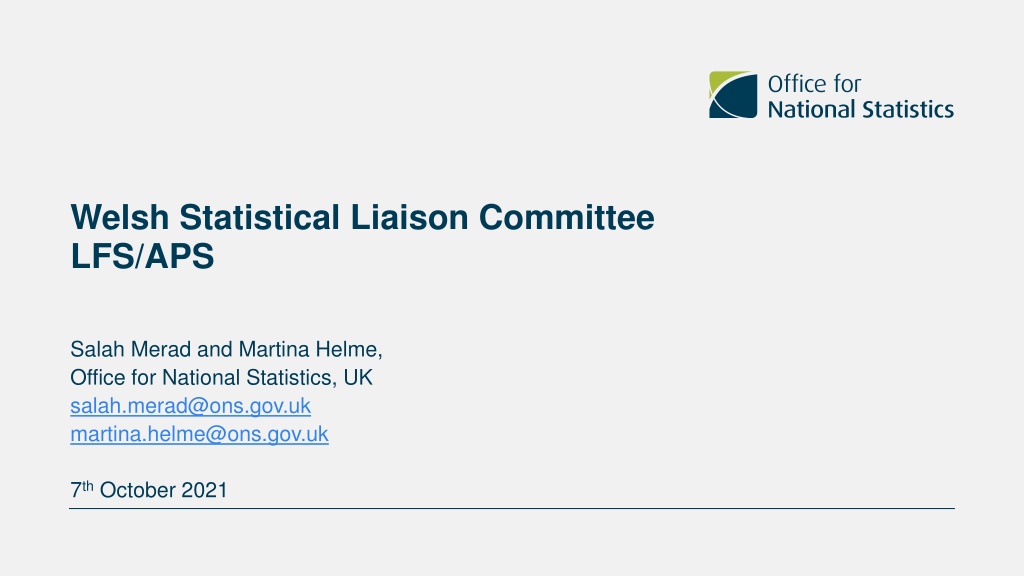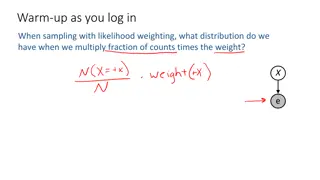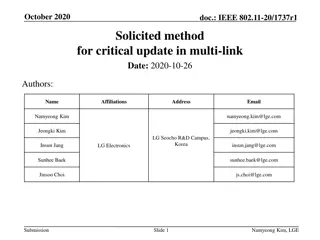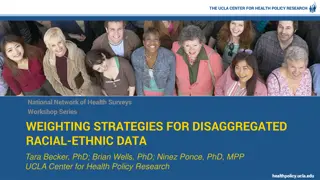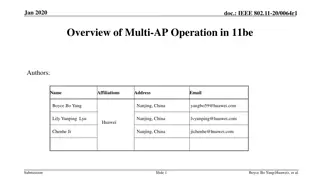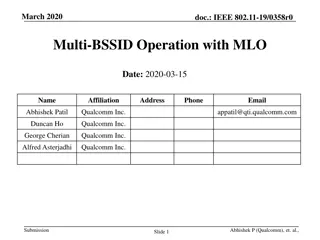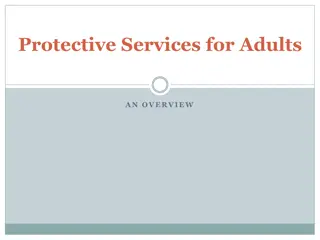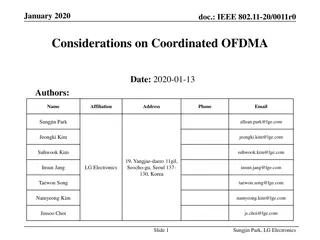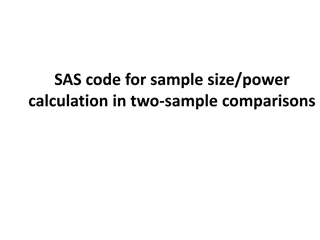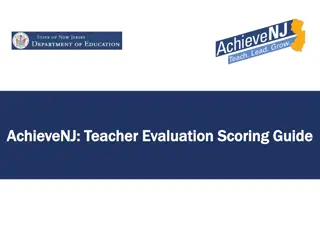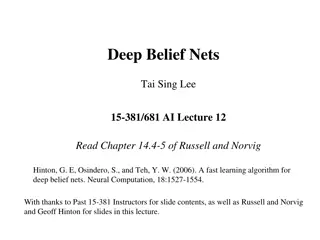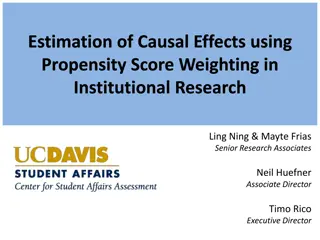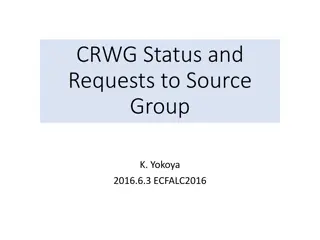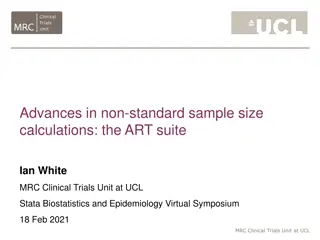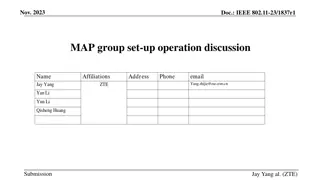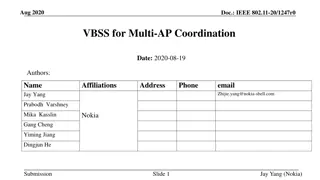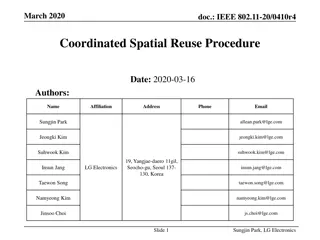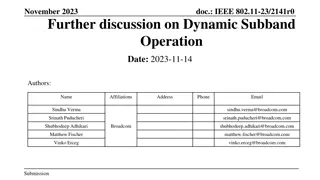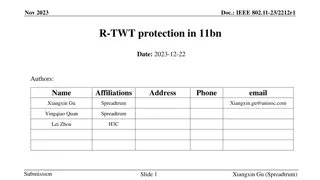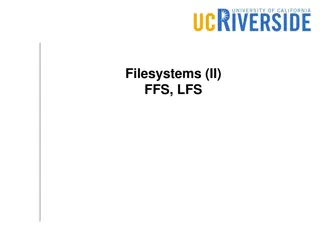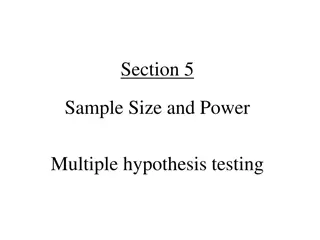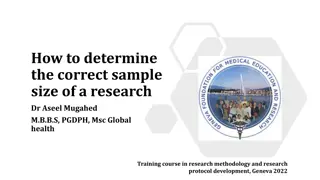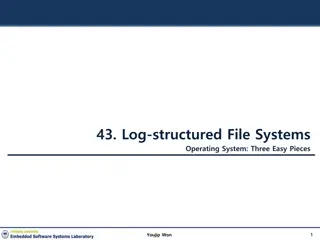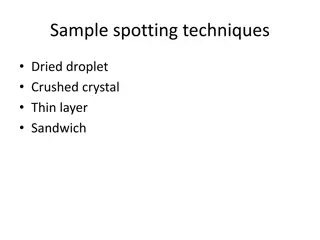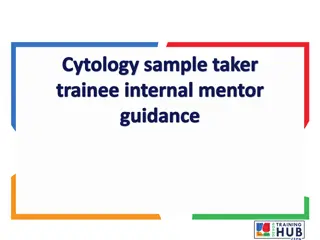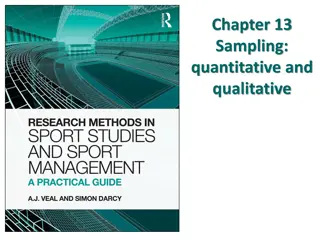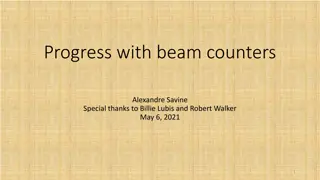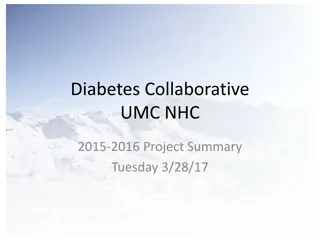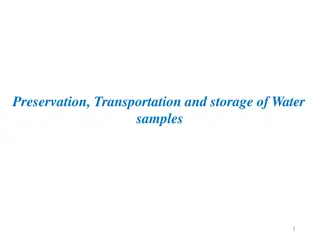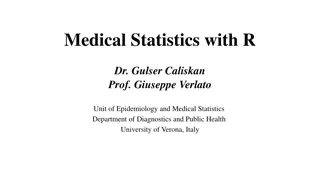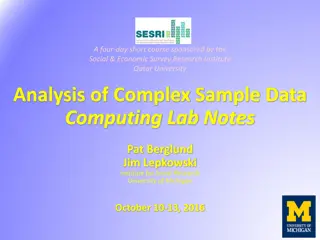Overview of LFS/APS Sample Design and Weighting Changes
The Welsh Statistical Liaison Committee discusses the sample design and weighting changes in the Labour Force Survey (LFS) and Annual Population Survey (APS) since the pandemic. It covers the impact on response rates, adjustments to reduce bias, and future developments. The LFS samples around 75,000 households per quarter, while the APS focuses on Local Authority-level analysis. The surveys have specific wave structures and replacement patterns to maintain data quality.
Download Presentation

Please find below an Image/Link to download the presentation.
The content on the website is provided AS IS for your information and personal use only. It may not be sold, licensed, or shared on other websites without obtaining consent from the author. Download presentation by click this link. If you encounter any issues during the download, it is possible that the publisher has removed the file from their server.
E N D
Presentation Transcript
Welsh Statistical Liaison Committee LFS/APS Salah Merad and Martina Helme, Office for National Statistics, UK salah.merad@ons.gov.uk martina.helme@ons.gov.uk 7thOctober 2021
Outline Brief overview of LFS/APS sample design and weighting Changes to the LFS since the start of the pandemic Impact on LFS response and sample bias Adjustments to reduce bias Implementing the adjustments: In LFS - impact on 2020 estimates In APS Future developments
Brief overview of APS/LFS sample design and weighting
LFS Sample Around 75,000 households sampled each quarter for the LFS and around 40,000 households take part This equals around 90,000 individuals every quarter Sample intended to be representative of the entire population Therefore each case weighted by age, sex and geography 65 million people 90,000 = each respondent is equivalent to approximately 800 people 75+ households and multiple households will have much larger weights The LFS is not of a sufficient size to allow for analysis at below Regional level
APS Sample Main purpose of the APS is that analysis can be conducted at Local Authority level The boost cases ensure a set number of cases for each Local Authority are targeted In Wales and inc. LFS main sample each quarter contains: - around 14,000 household interviews - around 25,000 individual interviews
LFS wave structure Wave 1 Wave 2 Wave 3 Wave 4 Wave 5 JM20 Respondents are interviewed for five successive waves at three- monthly intervals Wave 1 Wave 2 Wave 3 Wave 4 Wave 5 AJ20 Wave 1 Wave 2 Wave 3 Wave 4 Wave 5 JS20 20% of the sample is replaced every quarter Wave 1 Wave 2 Wave 3 Wave 4 Wave 5 OD20 Wave 1 Wave 2 Wave 3 Wave 4 Wave 5 JM21
LFS boost wave structure England, Scotland and Wales all fund Local Labour Force Survey interviews (LLFS, Boost or Enhancement cases) Respondents are interviewed for four successive waves at 12-monthly intervals 2017 Wave 1 Wave 2 Wave 3 Wave 4 2018 Wave 1 Wave 2 Wave 3 Wave 4 2019 Wave 1 Wave 2 Wave 3 Wave 4 2020 Wave 1 Wave 2 Wave 3 Wave 4 2021 Wave 1 Wave 2 Wave 3 Wave 4 25% of the sample is replaced every quarter
APS wave structure The APS is made up of LFS W1 and W5, and the LFS Boost W1-4 LFS W1 LFS W5 2017 Boost W1 Boost W2 Boost W3 Boost W4 LFS W1 LFS W5 2018 Boost W1 Boost W2 Boost W3 Boost W4 LFS W1 LFS W5 2019 Boost W1 Boost W2 Boost W3 Boost W4 LFS W1 LFS W5 2020 Boost W1 Boost W2 Boost W3 Boost W4 LFS W1 LFS W5 2021 Boost W1 Boost W2 Boost W3 Boost W4
LFS sample design and weighting The LFS is a rotating panel probability sample survey (5 waves in each quarter) Non-responders in wave k, k=2, ,5, who responded in wave k-1, are imputed The data are weighted to the UK resident population by age, sex and geography Students in halls of residence are part of the population but their data are collected from parents The population totals for the groups used in weighting are obtained from population projections by single year of age in each local authority that are based on mid-year population estimates
Changes to the LFS data collection since the start of the pandemic
Timeline of events 30/03 Telephone interviewing rolled out to F2F interviewers 17/03 F2F data collection suspended 01/07 W1 sample size doubled 23/03 UK lockdown begins 01/04 Roll-out of Knock-to- Nudge alongside W1 sample reduction 09/03 Public awareness starts affecting survey participation 20/04 Online portal for telephone details
What is Knock to Nudge (KtN)? Cases without phone contact details are assigned to an F2F interviewer Interviewer will make 3 call attempts to obtain phone contact details at the doorstep followed by a telephone interview if successful KtN is currently conducted on wave 1 cases, but only on wave 2-5 where phone contact details were incorrect or supplied late.
Impact on response and sample bias
Adjustment to reduce bias
Weighted distribution of household tenure Tenure over time 40% 38% 36% 34% 32% 30% 28% 26% JM18 AJ18 JS18 OD18 JM19 AJ19 JS19 OD19 Owner Mortgage Rent and Other Avg 2019 Owner Avg 2019 Mortgage Avg 2019 Rent and Other
Adjustments to weighting There is no explicit non-response adjustment in current weighting method We introduced additional calibration constraints Uniform weekly distribution of weighted sample by country Distribution of tenure set to the average of 2019 distribution Assumes minor structural change to the population Assumes available population projections to be fairly accurate
Considering other socio-economic variables: Highest qualification
Impact of pandemic on LFS estimates by country of birth Published estimates of employment by country of birth before recent reweighting Levels Year-on-year changes UK Total Non UK 5,796 5,777 5,770 5,809 5,893 5,574 5,176 5,014 UK Total Non UK Total1 Total1 Quarter Jan-Mar 2019 Apr-Jun 2019 Jul-Sep 2019 Oct-Dec 2019 Jan-Mar 2020 Apr-Jun 2020 Jul-Sep 2020 Oct-Dec 2020 32,641 32,752 32,802 32,983 32,998 32,592 32,515 32,441 26,838 26,967 27,028 27,171 27,097 27,004 27,328 27,422 357 -160 -288 -542 258 38 299 251 97 -203 -594 -795 Estimates by country of birth look implausible from April 2020 onwards
Impact of pandemic on non-UK born population Using all cases Quarter JM AJ JS 2019 2020 Change -189,809 -445,333 -893,766 9,436,495 9,413,650 9,248,509 9,246,686 8,968,317 8,354,743 Excluding imputed cases and wave 1 cases after mid-March 20 (75+ only) Quarter 2019 2020 Change Waves used JM AJ JS OD 8,778,739 8,941,893 8,453,521 8,651,552 8,997,224 8,052,690 7,860,823 7,931,272 218,485 All waves -889,203 Waves 2-5 -592,698 Waves 3-5 -720,280 Waves 4-5
Attrition analysis Attrition rates decreased in UK born after pandemic but increased in non-UK born in all age groups EU born dropped out more out of sample than non-EU born
Comparing LFS and RTI based estimates of growth (from HMRC, an administrative source ) LFS-based growth rates for non-UK decreased much more between Oct-Dec 19 and in Jul-Sep 20 than RTI-based growth rates It s very likely that LFS estimates suffer from bias stemming from differential non-response between UK and non-UK born that the additional tenure constraint hasn t reduced sufficiently We need to reduce this bias by adding a constraint on the structure of the population by country of birth
How can we use RTI data to estimate EU and non-EU born subpopulations? We want to estimate year-on-year population growth in each rolling quarter in 2020 onwards Very few observations from RTI are available to fit a statistical model Use simple assumptions to derive an expression of change in population growth rates in terms of change in RTI-based employee growth rates Oct-Dec 2019 (OD19) is the base period: Population growth is know Assumptions change in the population growth rate of the non-UK sub-populations is in the same direction as the change in their RTI employee growth rate the magnitude of change in population growth rate does not exceed that of change in RTI employee growth rate We consider July-September 2020 (JS20)
Method Let ????,??20,?? denote the RTI employee total growth rate of the EU born population between JS20 and JS19 Adjust RTI year-on-year percentage changes in non-UK subpopulations by differencing UK nationals rates ????,??20,??,???= ????,??20,?? ????,??20,?? ????,??20,??? ??,???= ????,??20,??? ?? ????,??20,?? Let ???19,?? denote the population growth rate of the EU born population between OD18 and OD19 Population growth rate for EU born since pandemic, ???20,??,??? for JS20 quarter, satisfies ?????,??,??? ?????,?? ? ????,????,??,??? ????,????,??,??? Where 0 < ? 1 b is set to to minimise mean prediction error
Evaluation using past RTI data and long-term international migration estimates (LTIM) Period Country of birth LTIM (000s) RTI-based estimates (000s) October - December 2016 EU 133 179 99 199 75 205 50 282 170 156 92 174 59 198 56 329 0.0 14.3 21 Non-EU October - December 2017 EU Non-EU October - December 2018 EU Non-EU October - December 2019 EU Non-EU Mean percentage deviation from LTIM Mean percentage absolute deviation from LTIM Mean absolute deviation from LTIM (in 1,000s)
Impact on the population size by country of birth LFS year-on-year change in population levels by country of birth Figures in 1000s Labour Force Survey RTI-based method Period UK Non-UK All UK Non-UK All January - March 2020 575 -192 383 96 302 398 April - June 2020 773 -394 379 34 265 299 July - September 2020 1,253 -880 373 16 214 230 October - December 2020 1,569 -1,203 366 -2 112 110
Implementing the adjustments in LFS
Reweighting method for LFS Separated sample into two parts: affected and unaffected by pandemic Applied a non-response adjustment to the affected part via a regression model that uses the area level factors IMD, OAC and Region The two parts were then combined before running the calibration Population totals for the non-UK born (EU and non-EU) were obtained by adjusting the weights of the previous year s LFS dataset by using the modelled population growth rates The UK born population was adjusted by applying a growth rate based on natural change The age, sex and geographical distributions used in weighting were based on population projections Added HH Tenure, weekly distribution and population size COB by region
Impact on economic activity estimates A non-response adjustment was applied to cases that joined the sample after the change in data collection using area level data from the census Economic activity (ILODEFR) Labour Force Survey RTI-based method Differences Levels (000s) 31,601 1,337 8,457 31,416 1,363 8,641 31,186 1,593 8,662 31,082 1,714 8,664 Rates (%) 76.3 4.1 20.4 75.8 4.2 20.9 75.3 4.9 20.9 75.0 5.2 20.9 Levels (000s) 31,589 1,331 8,484 31,261 1,332 8,777 31,006 1,711 8,635 30,874 1,750 8,676 Rates (%) 76.3 4.0 20.5 75.6 4.1 21.2 75.0 5.2 20.9 74.8 5.4 21.0 Levels (000s) -12 Rates (%) 0.0 -0.1 0.1 -0.2 -0.1 0.3 -0.3 0.3 0.0 -0.2 0.2 0.1 Quarter Employed Unemployed Inactive Employed Unemployed Inactive Employed Unemployed Inactive Employed Unemployed Inactive January - March 2020 -6 27 -154 -31 135 -180 118 -28 -207 36 12 April - June 2020 July - September 2020 October - December 2020
Reweighting method for APS Dataset was separated into quarterly subsets Non-response adjustment was applied to quarters containing data affected by the pandemic (from Jan 20) The quarterly subsets were combined into a single dataset Calibration using the following partitions Sex by DVAGE16 by EW_GrossingArea LA by working age GOR by sex by young age GB by quarter by week (totals from reweighted LFS) Household tenure (2019 LFS data) COB by GOVTOF (totals from reweighted LFS)
Future developments Consideration of further roll-out of KtN and reintroduction of face-to-face interviewing Continuing our work to transform population and migration statistics using admin data As further sources for estimates of the population become available (e.g. Census 2021), performance of LFS reweighting model will be assessed and further reweighting may take place if needed
Thank you ONS Methodology contact: Salah.Merad@ons.gov.uk ONS LFS Survey Research contact: Martina.Helme@ons.gov.uk
